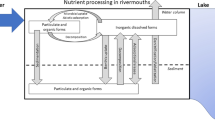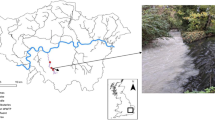Abstract
Benthic and hyporheic (i.e. the water-saturated interstitial zone beneath river bed-sediments) processes together modify particulate and dissolved nutrient fluxes in streams, but the relative importance of these processes remains unstudied in large rivers. Changes in material and nutrient fluxes (total suspended matter, biodegradable and refractory dissolved organic carbon, and nitrate) were monitored along a reach with a regulated discharge (a by-passed section downstream of a dam). Mass balance diagrams highlight a contrasting functioning between upstream and downstream parts of this sector of the Rhône River (Pierre-Bénite sector, France). At the upstream location close to the water input, characterized by partially clogged sediments and large lentic zones, decrease in total suspended matter (TSM) and biodegradable dissolved organic carbon (BDOC) fluxes resulted from high rates of benthic processes (i.e. sedimentation, respiration and mineralisation). At the downstream location, characterized by strong vertical water exchanges in a large riffle, nutrient changes resulted from the combination of processes that took place at the surface of the stream bed and during water percolation through riffle sediments. Physical benthic processes (scouring of periphyton, erosion and resuspension of sediment due to higher surface velocity) lead to an increase of TSM and DOC fluxes. Within the riffle, decomposition and mineralisation of organic matter in the first meter of the infiltration zone, and physical entrapment of RDOC, make the riffle as a sink for DOC and a source of nitrate. The significant contribution of the riffle to the self-purification capacities of this large river reach shows the relevance of including interstitial compartment in self-purification studies.
Similar content being viewed by others

References
Baker, M. A., C. N. Dahm & H. M. Valett, 1999. Acetate metabolism in the hyporheic zone of a mountain stream. Limnol. Oceanogr. 44: 1530–1539.
Battin, T., 1999. Hydrologic flow paths control dissolved organic carbon fluxes and metabolism in an alpine stream hyporheic zone. Wat. Res. Res. 35: 3159–3169.
Bencala, K. E., V. C. Kennedy, G. W. Zellweger, A. P. Jackman & R. J. Avanzino, 1984a. Interactions of solutes and streambed sediment 1. An experimental analysis of cation and anion transport in a mountain stream. Wat. Res. Res. 20: 1797–1803.
Bencala, K. E., V. C. Kennedy, G. W. Zellweger, A. P. Jackman & R. J. Avanzino, 1984b. Interactions of solutes and streambed sediment 2. A dynamic analysis of coupled hydrologic and chemical processes that determine solute transport. Wat. Res. Res. 20: 1804–1814.
Bencala, K. E., J. H. Duff, J. W. Harvey, A. P. Jackman & F. J. Triska, 1993. Modelling within the stream-catchment continuum. In Jakeman A. J., M. B. Beck & M. J. McAleer (eds), Modelling Change in Environmental Systems. Springer, New York: 313 pp.
Biggs, B. J. F. & M. E. Close, 1989. Periphyton biomass dynamics in gravel bed rivers: the relative effects of flow and nutrients. Freshwat. Biol. 22: 209–231
Blenkinsopp, S. A., P. A. Gabott, C. Freeman & M. A. Lock, 1991. Seasonal trends in river biofilm storage products and electron transport system activity. Freshwat. Biol. 26: 21–34.
Boulton, A. J., S. Findlay, P. Marmonier, E. H. Stanley & H. M. Valett, 1998. The functional significance of the hyporheic zone in streams and rivers. Ann. Rev. Ecol. Syst. 29: 59–81.
Brunke, M. & T. Gonser, 1997. The ecological significance of exchange processes between rivers and groundwater. Freshwat. Biol. 37: 1–33.
Cattaneo, A. & M.-C. Amireault, 1992. How artificial are artificial substrata for periphyton? J. n. am. Benthol. Soc. 11: 244–256.
CEMAGREF, 1995. Suivi de l'incidence de l'augmentation du débit réservé dans le Vieux Rhône de Pierre Bénite. Unpublished report: 115 p.
Chróst, R. J., 1991. Microbial enzymes in aquatic environments. In Overbeck J. & R. J. Chròst (eds), Aquatic Microbial Ecology. Springer, New York: 313 pp.
Claret, C., P. Marmonier, J.-M. Boissier, D. Fontvieille & P. Blanc, 1997. Nutrient transfer between parafluvial interstitial water and river water, influence of gravel bar heterogeneity. Freshwat. Biol. 37: 657–670.
Claret, C., P. Marmonier & J.-P. Bravard, 1998. Seasonal dynamics of nutrients and biofilms in interstitial habitats in two contrasted riffles in a regulated large river. Aquat. Sci. 60: 33–55.
Elwood, J. W., J. D. Newbold, R. W. O'Neil & W. Van Winkle, 1983. Resource spiralling: an optimal paradigm for analyzing lotic ecosystems. In Fontaine, T. D. (ed.), Dynamics of Lotic Ecosystems. Ann Arbor Science, U.S.A.: 494 pp.
Fiebig, D. M., 1995. Groundwater discharge and its contribution of dissolved organic carbon to an upland stream. Arch. Hydrobiol. 134: 129–155.
Findlay, S., 1995. Importance of surface-subsurface exchange in stream ecosystems: the hyporheic zone. Limnol. Oceanogr. 40: 159–164.
Fontvieille, D. & B. Cazelles, 1990. Modelisation of a lotic ecosystem polluted by a pigsywaste: dynamics of dissolved carbon and benthic microorganisms. Rev. Sci. Eau 2: 511–541.
Fisher, S. G., N. B. Grimm, E. Marti & R. Gomez, 1998. Hierarchy, spatial configuration and nutrient cycling in a desert stream. Aust. J. Ecol. 23: 41–52.
Freeman, C., M. C. Lock, J. Marxsen & S. Jones, 1990. Inhibitory effects of high molecular weight dissolved organic matter upon metabolic processes in biofilms from contrasting rivers and streams. Freshwat. Biol. 24: 159–166.
Freeze, D. R. & J. A. Cherry, 1979. Groundwater. Prentice-Hall, Englewood Cliffs, New-Jersey: 604 pp.
Harvey, J. W. & K. E. Bencala, 1993. The effect of streambed topography on surface-subsurface water exchange in mountain catchments. Wat. Res. Res. 29: 89–98.
Hendricks, S. P., 1996. Bacterial biomass, activity and production within the hyporheic zone of a north-temperate stream. Arch. Hydrobiol. 13: 467–487.
Hill, A. R. & D. J. Lymburner, 1998. Hyporheic zone and streamsubsurface exchange in groundwater-fed stream. Can. J. Fish. aquat. Sci. 55: 495–506. 131
Holm-Hansen, O. & B. Riemann, 1978. Chlorophyll A determination: improvements in methodology. Oikos, 30: 438–447.
Horner, R. R., E. B. Welch, M. R. Seeley & J. L. M. Jacoby, 1990. Responses of periphyton to changes in current velocity, suspended sediment and phosphorus concentration. Freshwat. Biol. 24: 215–232.
Jones, J. B. & R. M. Holmes, 1996. Surface-subsurface interactions in stream ecosystems. Trends Ecol. Evol. 11: 239–242.
Kellerhals, R. & D. I. Bray, 1971. Sampling procedures for coarse fluvial sediments. J. Hydraul. Div. ASCE. 97(Hy8): 1165–1180.
Klotz, R. L. & E. A. Matson, 1978. Dissolved organic carbon fluxes in the Shetucket River of eastern Connecticut, USA. Freshwat. Biol. 8: 347–355.
Lau,,Y. L. & D. Liu, 1993. Effect of flow rate on biofilm accumulation in open channels. Wat. Res. 3: 335–360.
Mann, C. J. & R. G Wetzel, 1995. Dissolved organic carbon and its utilization in a riverine wetland ecosystem. Biogeochemistry 31: 99–120.
Marmonier, P., D. Fontvieille, J. Gibert & V. Vanek, 1995. Distribution of dissolved organic carbon and bacteria at the interface between the Rhône river and its alluvial aquifer. J. n. amer. Benthol. Soc. 14: 382–392.
Morrice, J. A., H. M. Valett, C.N. Dahm & M. E. Campana, 1997. Alluvial characteristics, groundwater-surface water exchange and hydrologic retention in headwater streams. Hydrol. Process. 11: 253–267.
Newbold, J. D., P. J. Mulholland, J. W. Elwood & R. V. O'Neil, 1982. Organic carbon spiralling in stream ecosystems. Oikos 38: 266–272.
Osttroumov, S. A., 1998. Biological filtering and ecological machinery for self-purification and bioremediation in aquatic ecosystems: towards a holistic view. Riv. Biol. Biol. Forum 91: 221–232.
Pringle, C. M. & F. J. Triska, 1991. Effect of geothermal groundwater on nutrient dynamics of a lowland Costa Rican stream. Ecology 72: 951–965.
Servais, P., G. Billen & M.-C. Hascoët, 1987. Determination of the biodegradable dissolved organic matter in waters. Wat. Res. 21: 445–450.
Servais, P., A. Anzil & C. Ventresque, 1989. Simple method for determination of biodegradable organic carbon in water. Appl. Env. Microbiol. 55: 2732–2734.
Spellman, F. R., 1996 Stream Ecology and Self-purification. An Introduction for Wastewater and Water Specialists. Technomic Publishing Co. Lancaster, Pennsylvania, U.S.A.: 133 pp.
Stream SoluteWorkshop, 1990. Concepts and methods for assessing solute dynamics in stream ecosystems. J. n. am. Benthol. Soc. 9: 95–119.
Triska, F. J., V. C. Kennedy, R. J. Avanzino, G. W. Zellweger & K. E. Bencala, 1989. Retention and transport of nutrients in a thirdorder stream in northwestern California: hyporheic processes. Ecology 70: 1893–1905.
Triska, F. J., J. C. Duff & R. J. Avanzino, 1990. Influence of exchanges flow between the channel and hyporheic zone on nitrate production in a small mountain stream. Can. J. Fish. aqut. Sc. 47: 2099–2111.
Valett, H. M., S. G. Fisher & E. H. Stanley, 1990. Physical and chemical characteristics of the hyporheic zone of a Sonoran Desert stream. J. n. am. Benthol. Soc. 9: 201–215.
Valett, H. M., J. A. Morrice, C. N. Dahm & M. E. Campana, 1996. Parent lithology, surface-groundwater exchange and nitrate retention in headwater streams. Limnol. Oceanogr. 41: 333–345.
Vanek, V., 1987. The interaction between lake and groundwater and their ecological significance. Stygologia 3: 1–23.
Vervier, P., J. Gibert, P. Marmonier & M.-J. Dole-Olivier, 1992. A perspective on the permeability of the surface freshwatergroundwater ecotone. J. n. am. Benthol. Soc. 11: 93–102.
Wuhrmann, K., 1972. Stream purification. In Mitchell, R. (ed.), Water Pollution Microbiology. Wiley Interscience, New-York: 119–151.
Author information
Authors and Affiliations
Rights and permissions
About this article
Cite this article
Fauvet, G., Claret, C. & Marmonier, P. Influence of benthic and interstitial processes on nutrient changes along a regulated reach of a large river (Rhône River, France). Hydrobiologia 445, 121–131 (2001). https://doi.org/10.1023/A:1017540306550
Issue Date:
DOI: https://doi.org/10.1023/A:1017540306550



